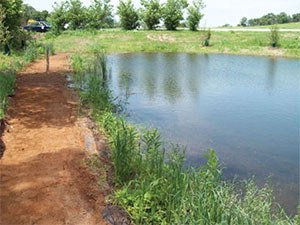New treatment practice removes dissolved phosphate from stormwater

Stormwater treatment practices have long focused on removing suspended solids and particles from stormwater runoff. As much as half of the pollutants in stormwater, however, are actually dissolved compounds, including nutrients such as phosphorus. These pollutants are not settled or filtered in many existing stormwater runoff treatment systems found across the region, state, and nation.
Researchers at the U of M’s St. Anthony Falls Laboratory (SAFL)—led by research scientist Andrew Erickson and professors Peter Weiss and John Gulliver—have identified techniques to remove the dissolved compound phosphate from stormwater, with excellent results. Their iron-enhanced sand filtration system, named the Minnesota Filter, has been installed in a number of locations around the Minneapolis–St. Paul metro region. The research was funded by the Minnesota Local Road Research Board.
The Minnesota Filter is a new technique in which iron filings are added to a sand filtration system. When exposed to rainfall, the iron forms iron oxides (rust), which adsorb phosphate. The system can be used in many applications including surface sand filters, wet detention basins, permeable weirs, ditch check blocks, and rain gardens, Erickson says.
The system was first installed in Maplewood in 2009 using 5 percent iron filings by weight. A number of similar systems have been installed, such as a field test in Prior Lake that used 7 percent iron filings in trenches for wet detention ponds. Results from monitoring initial installations show an average of 70 percent phosphate reduction in stormwater.
The cost of the system depends on the size and type of the installation. In one example, a quarter-acre site, material and labor costs increased by about 15 percent (for mixing the sand and iron). For other applications, more efficient approaches could get the additional cost down to perhaps 5 percent or 10 percent. “We’re improving that all the time with how we spec it,” Erickson says. “And even though it costs more, other practices are not touching that dissolved fraction.”
Cliff Aichinger, district administrator for Ramsey Washington Metro Watershed District, says the Minnesota Filter has “worked extremely well.” Aichinger was a member of the technical advisory panel for the original project that developed this technology, and his district did the first field installation. “We have adopted it as a practice virtually every chance we get,” he says. “And the cost is minimal.”
Not all sites are candidates for a Minnesota Filter. Pollutants carried by stormwater can vary greatly with different locations, storms, times of year, and pollutant sources, Erickson explains. Most urban watersheds need to treat both solids and dissolved compounds.
Since the installations are relatively new, maintenance requirements are still being determined. Lab modeling indicates the system will last more than 35 years before the iron runs out of capacity, which is longer than the design life of most filter systems. The next several years of monitoring will provide data about maintenance cycles and disposal issues, Erickson says.
Photos: SAFL and Andrew Erickson
